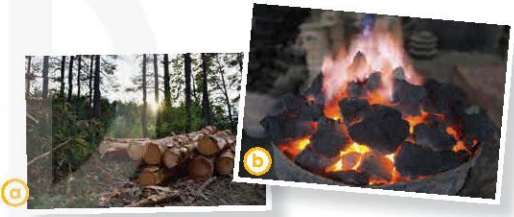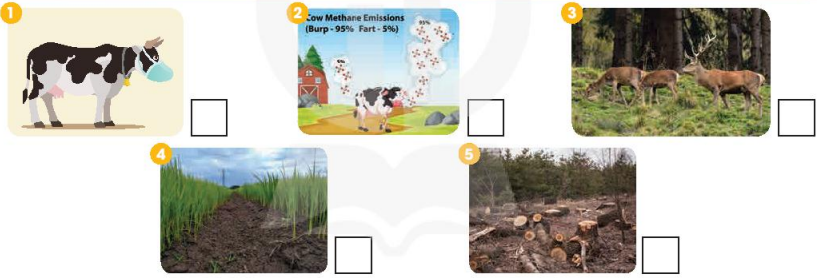Giải SGK, SBT Unit 5. Global warming Global Success
Giải SGK, SBT Unit 5 Global Success
3. Match the words to make phrases used in 1.
(Nối các từ để tạo thành các cụm từ được sử dụng trong bài 1.)
|
1. global |
a. activities |
|
2. heat - trapping |
b. gases |
|
3. greenhouse |
c. warming |
|
4. human |
d. levels |
|
5. sea |
e. pollutants |
3. Read the article again. Match the highlighted words with their meanings.
(Đọc lại bài viết. Nối các từ được đánh dấu với ý nghĩa của chúng.)
|
1. emissions |
a. a gas without smell or colour, often used as a fuel |
|
2. balance |
b. a chemical substance found in all living things |
|
3. carbon |
c. a situation in which different things are equal |
|
4. methane |
d. gases or other substances that are sent into the atmosphere |
Human activities and global warming
(Các hoạt động của con người và sự nóng lên toàn cầu)
1. Match the activities (1 - 3) with their possible effects on the environment (a - f).
(Nối các hoạt động (1 - 3) với các tác động có thể có của chúng đối với môi trường (a - f).)
|
1. Cutting down or burning forests |
a. When burnt, fossil fuels release greenhouse gases, trapping heat in the atmosphere. |
|
b. When eating, these animals produce a lot of methane. This gas is responsible for nearly one-third of current global warming. |
|
|
2. Burning coal, oil, and gas |
c. Trees use CO2 to grow, so when they are cut down or burnt, the CO2 in the air increase. |
|
d. Carbon from fossil fuels combines with oxygen in the air to form large amounts of CO2. |
|
|
3. Raising farm animals like goats, sheep, and cows |
e. Forests store carbon in the trees and soil, and help reduce the global temperature. |
|
f. Forests are cut down to make space for farm animals. |
3. Work in pairs. Talk about the other human activities that contribute to global warming. Use the ideas in 1, the model and the tips in 2 to help you.
(Làm việc theo cặp. Nói về các hoạt động khác của con người góp phần vào sự nóng lên toàn cầu. Sử dụng ý tưởng trong phần 1, mô hình và mẹo trong phần 2 để giúp bạn.)
|
Tips (Mẹo) To present your ideas clearly in a discussion, you should: (Để trình bày ý tưởng của bạn một cách rõ ràng trong một cuộc thảo luận, bạn nên) • state your opinion directly, e.g. I think/ believe the most serious problem is burning coal, oil, and gas. (nêu ý kiến của bạn một cách trực tiếp, ví dụ: Tôi nghĩ/tin rằng vấn đề nghiêm trọng nhất là đốt than, dầu và khí đốt.) • introduce your arguments, e.g. There are two main reasons. (giới thiệu lập luận của bạn, ví dụ. Có hai lý do chính.) • use linking words to order your arguments, e.g. First,/Second, ... (sử dụng các từ nối để sắp xếp các lập luận của bạn, ví dụ: Thứ nhất,/Thứ hai, ...) Besides,/Moreover,/In addition, .... (Bên cạnh đó,/Hơn nữa,/Ngoài ra, ....) Last,/Finally,... (Cuối cùng,/Cuối cùng,...) |
Black carbon and global temperature
(Cacbon đen và nhiệt độ toàn cầu)
1. Work in pairs. Match the words with their meanings.
(Làm việc theo cặp. Nối các từ với ý nghĩa của chúng.)
|
1. soot |
a. to make or become liquid by heating |
|
2. melt |
b. the upper layer or the earth in which trees and plants grow |
|
3. crop |
c. tiny pieces of black dust that are produced when wood, coal, etc. is burnt |
|
4. soil |
d. a plant such as rice or fruit, grown by farmers and used as food |
A leaflet about ways to reduce black carbon emissions
(Tờ rơi về cách giảm lượng khí thải carbon đen)
1. Work in pairs. Match the ways to reduce black carbon emissions (1-3) with the reasons (a-i) for doing so.
(Làm việc theo cặp. Nối các cách để giảm lượng khí thải carbon đen (1-3) với lý do (a-i) để làm như vậy.)
|
1. Stop burning waste 2. Stop using solid fuels at home 3. Switch to renewable energy
|
a. Soot from open waste burning has a strong warming effect on the earth. b. Renewable energy is clean, so it doesn't pollute the environment, c. The burning of waste in open fires is bad for the environment. d. The burning of organic waste produces nearly one-third of global black carbon emissions. e. Fossil fuels will be used up in this century while renewable energy will never run out because it comes from natural sources. f. Household air pollution kills millions of people yearly. g. Used for cooking or heating, solid fuels like coal and wood release black carbon and other pollutants. h. Renewable energy can replace fossil fuels because it is convenient and reliable. i. The tiny pieces of black carbon released from indoor stoves can enter the human body and cause serious health problems. |
2. Work in pairs. Use the model in 1 to make similar conversations for these situations. One of you is Student A, the other is Student B. Use the expressions below to help you.
(Làm việc theo cặp. Sử dụng mô hình trong 1 để thực hiện các cuộc hội thoại tương tự cho các tình huống này. Một trong số các bạn là Học sinh A, người kia là Học sinh B. Sử dụng các cách diễn đạt dưới đây để giúp bạn.)
1. Student A is burning rubbish. Student B is warning him/her about the dangers of open waste burning to people's health and the environment.
(Học sinh A đang đốt rác. Học sinh B đang cảnh báo bạn ấy về sự nguy hiểm của việc đốt rác lộ thiên đối với sức khỏe con người và môi trường.)
2. Student B is building a campfire. Student A is warning him/her about the risk of starting a forest fire and the health risks.
(Học sinh B đang đốt lửa trại. Học sinh A đang cảnh báo em ấy về nguy cơ bắt đầu cháy rừng và những rủi ro về sức khỏe.)
|
Useful expressions (Cách trình bày hữu ích) |
|
|
Giving warnings (Đưa ra lời cảnh báo) |
Responding to warnings (Đáp lại lời cảnh báo) |
|
- I wouldn’t … if I were you. (Tôi sẽ không … nếu tôi là bạn.) - Watch out (for something)! (Cẩn thận!) - I (must) warn you … (Tôi phải cảnh báo bạn.) - Mind your … (Hãy suy nghĩ …) |
- Thanks for (the) warning. (Cảm ơn lời cảnh báo.) - I’ll be (more) careful (next time). (Tôi sẽ cẩn thận (hơn và lần tới).) - Thanks. (Cảm ơn.) - Oh, really? I didn’t know that. Thanks so much. (Ồ, thật á? Mình đã không biết điều đó. Cảm ơn rất nhiều.) |













